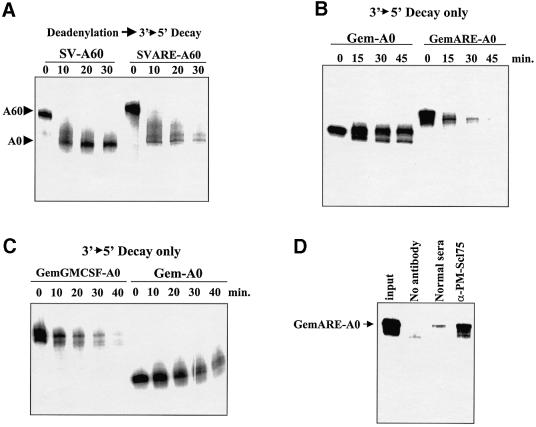Fig. 5. 3′–5′ Decay is regulated by AU-rich instability elements. (A) Polyadenylated SV-A60 RNA or a derivative that contains the 34 base ARE from TNF-α (SVARE-A60) was incubated with HeLa S100 cytoplasmic extracts for the times indicated. Reaction products were analyzed on a 5% acrylamide gel containing 7 M urea. The positions of the polyadenylated input RNAs and deadenylated intermediates are indicated on the left. Note that while the rate of deadenylation is only moderately affected, the presence of an ARE greatly stimulates the decay of the SVARE-A60 transcript. (B) Gem-A0 RNA [which lacks a poly(A) tail] or a derivative that contains the 34 base ARE from TNF-α (GemARE-A0) was incubated with HeLa S100 cytoplasmic extracts for the times indicated. Reaction products were analyzed on a 5% acrylamide gel containing 7 M urea. (C) Gem-A0 RNA or a derivative that contains the 51 base ARE from GMCSF (GemGMCSF-A0) was incubated with HeLa S100 cytoplasmic extracts for the times indicated. Reaction products were analyzed on a 5% acrylamide gel containing 7 M urea. (D) GemARE-A0 RNA was incubated in the in vitro decay assay for 30 min using either untreated S100 extract (lane no antibody), extract that was treated with normal serum (lane normal sera) or extract that had been immunodepleted with antibodies specific for PM-Scl75 protein (lane α-PM-Scl75). Reaction products were analyzed on a 5% acrylamide gel containing 7 M urea.

An official website of the United States government
Here's how you know
Official websites use .gov
A
.gov website belongs to an official
government organization in the United States.
Secure .gov websites use HTTPS
A lock (
) or https:// means you've safely
connected to the .gov website. Share sensitive
information only on official, secure websites.
